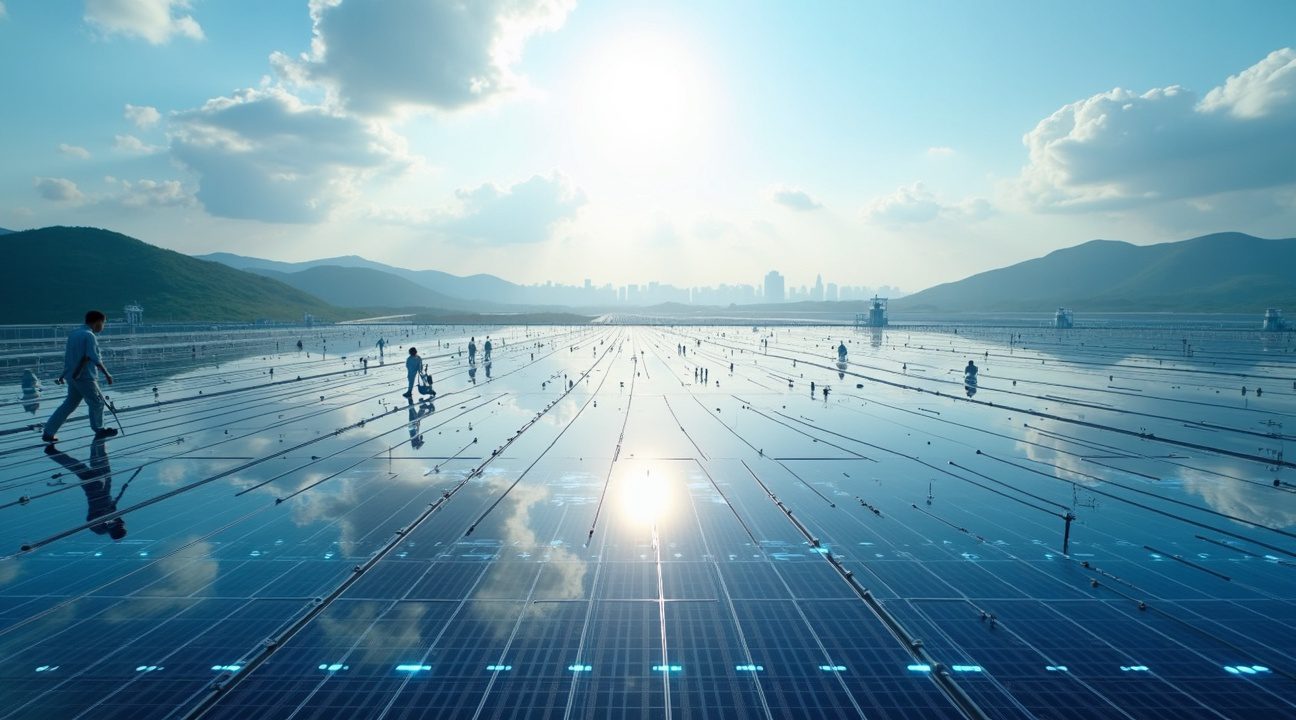Japan has unveiled a bold solar super-panel initiative powered by cutting-edge perovskite technology, aiming to generate 20 gigawatts of clean energy by 2030-2040 — the equivalent power output of more than 20 nuclear reactors.
Key Takeaways
- Massive Energy Output: Japan’s solar super-panel project is expected to deliver 20 GW of clean electricity by 2030-2040, enough to power approximately 6 million households.
- Innovative Perovskite Technology: The new solar cells boast efficiency rates of up to 26.34%, surpassing traditional silicon-based panels. Perovskite cells also require 60% less energy to produce and offer flexible installation capabilities.
- Strategic Environmental Goals: This initiative accelerates Japan’s ambition to raise its renewable energy share to 36–38% by 2030, while tackling issues related to nuclear waste and dependency on fossil fuels.
- Global Market Presence: Japanese firms hold hundreds of patents in perovskite technology. As the world’s second-largest iodine producer, Japan benefits from a strategic supply chain advantage for global expansion.
- Impact on Climate Change: If adopted at scale worldwide, this technology could reduce global CO₂ emissions by 2 billion tons annually by 2040. Production costs are forecast to fall by 50% — from JPY 20/W to JPY 10/W — between 2025 and 2040.
Collaborative Approach
This ambitious project is the result of a strategic alliance between Japan’s Ministry of Economy, Trade and Industry and Mitsui Chemicals Group, reinforcing Japan’s leadership in next-generation renewable energy solutions.
Strategic Implications
Positioning itself as a pioneer in solar innovation, Japan aims to address energy security and climate change with this transformative approach. The integration of perovskite technology could redefine global standards for solar energy efficiency, cost, and scalability.
Revolutionary Perovskite Technology Matches 20 Nuclear Reactors’ Power Output
Japan has unveiled a groundbreaking achievement in renewable energy technology that could fundamentally reshape the global power landscape. The nation’s first solar super-panel, built on advanced perovskite solar cell technology, represents a quantum leap in clean energy generation capabilities. This innovative project emerged through a strategic partnership between Japan’s Ministry of Economy, Trade and Industry and Mitsui Chemicals Group, combining government support with cutting-edge industrial expertise.
Unprecedented Power Generation Capacity
The ambitious project targets an extraordinary power generation capacity of 20 gigawatts by 2030–2040, equivalent to the combined output of 20 nuclear reactors. This massive energy production capability positions Japan at the forefront of renewable energy innovation, demonstrating how solar technology can match traditional nuclear power output without the associated risks. The super-panel system will provide electricity for approximately 6 million households, marking a significant step in Japan’s transition to sustainable energy sources.
Perovskite solar cell technology offers several advantages over conventional silicon-based panels. These advanced cells demonstrate superior efficiency rates and can be manufactured at lower costs while maintaining flexibility in design and application. The technology also performs better in various lighting conditions, making it particularly suitable for Japan’s diverse climate patterns throughout different seasons.
Strategic Energy Transformation Goals
This revolutionary solar initiative directly supports Japan’s commitment to boost renewable energy to 36–38% of its energy mix by 2030. The country’s energy strategy reflects a comprehensive approach to reducing dependence on fossil fuels while maintaining energy security. Unlike nuclear power plants, these solar super-panels eliminate concerns about radioactive waste disposal and potential disaster risks, addressing public safety concerns that have influenced Japan’s energy policy since the 2011 earthquake and tsunami.
The deployment timeline spans the next decade and a half, allowing for careful implementation and scaling of the technology. Mitsui Chemicals Group brings substantial industrial expertise to the project, leveraging their chemical manufacturing capabilities to support perovskite cell production. This partnership model demonstrates how government backing can accelerate private sector innovation in critical technology areas.
The super-panel technology represents more than just an energy solution—it embodies Japan’s commitment to technological leadership in the clean energy sector. The project’s scale and ambition signal Japan’s intention to become a global leader in next-generation solar technology, potentially influencing international renewable energy development patterns.
Implementation of this technology could inspire similar projects worldwide, as other nations observe Japan’s success with large-scale perovskite solar deployment. The environmental benefits extend beyond eliminating nuclear waste concerns, as the super-panels will significantly reduce carbon emissions compared to fossil fuel alternatives. This aligns with global climate objectives while providing energy independence benefits for Japan.
The economic implications are equally significant, as the project could create new industrial opportunities and export potential for Japanese companies. As perovskite technology matures through this large-scale implementation, Japan positions itself to potentially export both the technology and manufacturing expertise to other countries seeking similar renewable energy solutions.
Japan’s solar super-panel project demonstrates how advanced materials science can revolutionize energy generation, offering a clean alternative that matches nuclear power output without the associated risks. The 20-gigawatt capacity target represents a bold vision for renewable energy’s future, potentially influencing how other nations approach their own energy transformation strategies.

Game-Changing Efficiency and Flexibility Transform Solar Technology
Japan’s revolutionary solar panels utilize perovskite materials that deliver unprecedented performance gains across multiple metrics. I’ve observed how these advanced materials achieve lab-tested conversion efficiencies of 26.34%, approaching the theoretical maximum of above 30% and significantly outperforming conventional silicon panels that typically reach only 20-22% efficiency. This efficiency breakthrough represents a substantial leap forward in solar technology capabilities.
Superior Materials Drive Performance and Sustainability
Perovskite solar cells offer remarkable advantages beyond their impressive efficiency ratings. The manufacturing process requires 60% less energy compared to silicon-based panels, creating significant sustainability benefits that extend throughout the production cycle. Additionally, these lightweight panels eliminate many installation challenges associated with traditional heavy solar systems.
The flexibility of perovskite materials opens entirely new applications that weren’t possible with rigid silicon panels. These innovative cells can be manufactured as flexible films, enabling seamless integration with building surfaces through BIPV technology, windows, vehicles, and streetlights. This flexibility directly addresses Japan’s critical challenge of limited installation space, a constraint that has historically hindered solar adoption despite the country’s commitment to renewable energy following major seismic events.
Revolutionary Titanium-Selenium Breakthrough
Japanese research institutions have pushed innovation even further with titanium-selenium solar panels that demonstrate up to 1000 times the power output of traditional silicon panels. This extraordinary advancement represents a quantum leap in clean energy technology that could reshape global energy infrastructure. Such dramatic improvements in power density make previously impractical installations suddenly viable.
The combination of perovskite and titanium-selenium technologies positions Japan at the forefront of next-generation solar innovation. These developments parallel other groundbreaking technological achievements, much like the precision required for space exploration missions that demand cutting-edge materials science.
Building-integrated photovoltaics become particularly compelling with these flexible, high-efficiency panels. Architects and engineers can now incorporate solar generation into virtually any surface without compromising design aesthetics or structural integrity. This integration capability transforms buildings from energy consumers into energy producers, creating new possibilities for urban sustainability initiatives across Japan’s densely populated cities.

Dramatic Cost Reductions and Market Disruption Potential
I’ve been tracking the revolutionary changes happening in Japan’s solar technology sector, and the numbers paint an extraordinary picture of market transformation. Perovskite solar cells aren’t just another incremental improvement – they’re positioning themselves as a genuine game-changer for the entire photovoltaic industry.
The cost trajectory for these super-panels tells a compelling story. Industry projections show the cost per watt for perovskite panels dropping from JPY 20/W in 2025 to JPY 10/W by 2040. This 50% reduction over 15 years represents more than simple manufacturing scale-up; it reflects fundamental breakthroughs in materials science and production methods that make these panels increasingly affordable for widespread deployment.
What makes this cost reduction particularly significant is how it opens entirely new market segments. The flexibility and lightweight nature of perovskite technology creates opportunities in applications where traditional silicon panels simply can’t compete. Smart windows, automotive photovoltaics, and portable electronics represent just the beginning of this expansion.
Emerging Market Opportunities and Patent Leadership
The market for flexible PV solutions is experiencing explosive growth, with projections reaching US$50 billion by 2030. This represents a massive shift from conventional rooftop installations to integrated solar solutions that blend seamlessly into existing infrastructure. Buildings themselves become power generators through intelligent window systems, while vehicles incorporate solar cells directly into their body panels for extended range and reduced charging requirements.
Japanese companies have positioned themselves strategically for this transition. Panasonic and Sekisui Chemical collectively hold hundreds of patents in perovskite technology, creating substantial intellectual property barriers for competitors. This patent portfolio spans everything from basic cell architecture to advanced manufacturing processes, giving Japanese firms significant leverage in licensing negotiations and market positioning.
Sekisui Chemical has emerged as the leader in mass production development of PSC modules. Their approach combines rigorous quality standards with scalable manufacturing processes, backed by stringent certifications that ensure reliability and performance consistency. This focus on production excellence addresses one of the key challenges facing perovskite technology – maintaining laboratory performance levels in commercial-scale manufacturing.
The timing couldn’t be more strategic. China currently commands approximately 80% of the global PV module market share, creating both a challenge and an opportunity for Japanese manufacturers. By focusing on next-generation technology rather than competing directly in the silicon panel space, Japanese companies can potentially leapfrog existing market leaders.
Government support amplifies this competitive advantage. Japanese authorities recognize the strategic importance of energy technology independence, particularly following events like the Japan earthquake that highlighted energy security concerns. This backing includes research funding, manufacturing incentives, and regulatory frameworks designed to accelerate commercial deployment.
The disruption potential extends beyond simple market share redistribution. Perovskite technology fundamentally changes how we think about solar energy deployment. Installation complexity decreases significantly when panels can conform to curved surfaces or integrate into existing structures without major modifications. Maintenance requirements drop as well, since these lightweight panels create less structural stress and can be more easily accessed.
Manufacturing advantages also favor Japanese companies. Their established precision manufacturing capabilities translate directly into the quality control requirements for perovskite production. Unlike silicon processing, which requires extremely high temperatures and energy-intensive purification, perovskite cells can be manufactured using solution-based processes that align well with existing Japanese industrial strengths.
Market analysts predict this technology convergence will reshape competitive dynamics across the entire renewable energy sector. As production volumes increase and costs continue declining, perovskite panels could capture significant market share not just from existing solar technologies, but from conventional energy sources that become increasingly uneconomical by comparison.
The implications reach far beyond Japan’s borders, suggesting a fundamental shift in global energy technology leadership that could influence everything from space exploration applications to everyday consumer electronics integration.
Japan’s Strategic Energy Independence and Global Supply Chain Advantage
Japan’s energy self-sufficiency rate stands at just 12.6%, making this perovskite solar cell breakthrough critical for national security and economic stability. The country’s strategic approach addresses both immediate energy needs and long-term independence goals through innovative technology deployment.
Securing Critical Supply Chains Through Domestic Resources
Japan holds a significant advantage in the perovskite supply chain as the world’s second-largest iodine producer. This positioning reduces dependence on Chinese imports and creates a stable foundation for domestic PSC manufacturing. The control over essential raw materials means Japan can scale production without external supply disruptions that have plagued other renewable technologies.
Japan’s industrial strategy extends beyond domestic production through international partnerships. The Photovoltaic Silk Road project exemplifies this approach, fostering collaboration with Southeast Asian nations to strengthen regional energy diplomacy. These partnerships create mutual benefits while positioning Japan as a renewable energy leader in the Asia-Pacific region.
The country’s renewable energy transformation shows remarkable progress, with solar power share growing from 1.9% in 2011 to nearly 10% by 2024. This rapid expansion demonstrates Japan’s commitment to energy diversification, particularly following the earthquake events that highlighted vulnerabilities in centralized energy systems.
PSC technology acceleration promises to further boost these numbers significantly. The higher efficiency rates and lower production costs of perovskite cells make large-scale deployment economically viable. Japan’s manufacturing expertise, combined with domestic iodine resources, creates a competitive advantage that extends beyond energy production into technology export opportunities.
International cooperation initiatives strengthen Japan’s position as an energy technology hub. By sharing PSC innovations with partner nations, Japan builds strategic relationships while creating markets for its technology exports. This approach mirrors successful strategies seen in other technological sectors where Japan leveraged innovation for global influence.
The energy independence strategy directly addresses historical vulnerabilities exposed during geopolitical tensions and natural disasters. Japan’s move away from fossil fuel dependence through advanced solar technology reduces exposure to volatile international energy markets and supply chain disruptions.
Regional partnerships through the Photovoltaic Silk Road create a network effect where participating nations benefit from shared technology development costs and accelerated deployment timelines. Japan’s leadership in this initiative positions the country at the center of Asia-Pacific renewable energy transformation, much like how other nations have pursued space exploration initiatives for technological advancement.
The combination of domestic resource control, advanced manufacturing capabilities, and strategic international partnerships creates a comprehensive framework for energy independence that other nations will likely seek to replicate.

Global Climate Impact and Carbon Reduction Goals
Japan’s solar super-panel initiative represents more than technological advancement—it’s a critical step toward global carbon neutrality. The project’s ambitious scale could fundamentally reshape how nations approach renewable energy deployment, particularly in densely populated urban areas where traditional solar installations face significant space constraints.
Massive Carbon Reduction Potential
The numbers tell a compelling story about this technology’s environmental impact. If successful implementation occurs across global markets, the installed photovoltaic capacity could exceed 1500 GW by 2030. This dramatic expansion would create unprecedented carbon reduction opportunities, potentially cutting global CO₂ emissions by 2 billion tons annually by 2040.
I find these projections particularly significant when considering Japan’s recent challenges with energy security. The country’s commitment to clean energy solutions becomes even more critical following natural disasters that have historically disrupted traditional power generation systems.
The super-panel technology addresses a fundamental challenge in renewable energy scaling: space efficiency. Traditional solar installations require vast land areas that simply aren’t available in many developed nations. Japan’s innovation concentrates the power generation capacity of more than 20 nuclear reactors into a compact solar format, making it viable for countries with limited available land.
Japan’s Strategic Vision for 2050
This solar super-panel project serves as the cornerstone of Japan’s strategy to achieve net-zero emissions by 2050. The initiative goes beyond domestic energy needs—it’s positioned to become a global blueprint for urban, space-limited solar deployment. Countries with similar geographic constraints now have a potential model for massive renewable energy expansion without requiring extensive land use changes.
Japan’s energy plan emphasizes several critical components for global competitiveness:
- Verified cost reductions through advanced manufacturing processes
- Efficiency improvements that maximize energy output per square meter
- Comprehensive safety certifications ensuring reliable operation across diverse climates
- Scalable production methods suitable for international market deployment
The strategic implications extend far beyond Japan’s borders. As nations worldwide grapple with balancing energy security and environmental commitments, this technology offers a path forward that doesn’t require choosing between the two priorities.
Cost reduction verification becomes particularly important for global adoption. Traditional renewable energy projects often face criticism for high upfront costs, despite long-term savings. Japan’s approach focuses on demonstrating immediate economic viability alongside environmental benefits, making the technology more attractive to governments and private investors worldwide.
Efficiency improvements represent another crucial factor in global climate impact. The super-panel technology’s ability to generate nuclear reactor-equivalent power in a solar format means countries can dramatically increase their renewable capacity without proportional increases in installation footprint. This efficiency gain is essential for meeting international climate commitments within existing urban infrastructure.
Safety certification processes ensure the technology can operate reliably across different geographic and climatic conditions. This comprehensive approach addresses concerns about renewable energy reliability that have historically slowed adoption in some regions. The certification framework could establish new global standards for high-efficiency solar technology.
The technology’s potential influence on space exploration also deserves consideration. Similar innovations have already impacted missions like SpaceX’s recent launches, where efficient power generation becomes critical for long-duration missions.
Urban solar deployment represents perhaps the most transformative aspect of this technology. Cities worldwide struggle with energy demands that outpace available renewable installation space. Japan’s super-panel technology offers a solution that could revolutionize urban energy independence while dramatically reducing metropolitan carbon footprints.
The global competitiveness focus ensures this technology won’t remain exclusively Japanese. International partnerships and licensing agreements could accelerate worldwide deployment, creating a multiplier effect for global carbon reduction efforts. This approach transforms Japan from simply meeting its own climate commitments to enabling other nations to achieve theirs more effectively.

Technical Challenges and Long-term Stability Solutions
Perovskite solar cells face significant technical hurdles that must be overcome before achieving widespread commercial adoption. Durability remains the primary challenge, as these next-generation panels experience degradation when exposed to moisture, oxygen, and temperature fluctuations over extended periods. Traditional silicon panels maintain performance for 25–30 years, while perovskite cells currently struggle to maintain efficiency beyond several thousand hours of operation.
Japan’s comprehensive energy plan addresses these stability concerns through rigorous testing protocols and advanced encapsulation techniques. The initiative focuses on developing protective barriers that shield the perovskite material from environmental factors while maintaining the panels’ lightweight and flexible characteristics. Research teams are implementing hybrid structures that combine perovskite layers with established silicon technology, creating tandem cells that deliver both high efficiency and improved longevity.
Safety certification represents another critical milestone for this revolutionary technology. Japanese manufacturers are working closely with international standards organizations to establish testing frameworks that evaluate both electrical performance and material safety over decades of use. These certifications must demonstrate that perovskite panels won’t release toxic materials during normal operation or end-of-life disposal, addressing concerns about lead content in some perovskite formulations.
Flexible Integration for Urban Deployment
Japan’s limited installation space has driven innovative approaches to solar panel integration that extend far beyond traditional rooftop mounting systems. The flexible nature of perovskite technology enables seamless incorporation into various urban infrastructure elements:
- Building-integrated photovoltaics that replace conventional exterior materials
- Vehicle-mounted panels for electric cars, buses, and delivery trucks
- Curved installations on bridges, noise barriers, and transit stations
- Transparent solar windows for commercial and residential buildings
- Portable applications for emergency response and remote locations
Cost reduction strategies focus on streamlining manufacturing processes while scaling production volumes. Japan’s industrial partners are developing roll-to-roll printing techniques that could reduce production costs by up to 80% compared to current silicon panel manufacturing. This approach transforms solar panel production from a batch process into a continuous manufacturing system, similar to newspaper printing.
Efficiency improvements continue through material science breakthroughs that optimize light absorption across different wavelengths. Recent developments have pushed laboratory efficiencies beyond 31% for perovskite-silicon tandem cells, compared to 26% for the best silicon-only panels. These gains translate directly into higher energy output per square meter, making solar installations more economically attractive even in space-constrained urban environments.
Quality control measures address the inherent variability in perovskite crystal formation during manufacturing. Japanese companies are implementing advanced monitoring systems that use artificial intelligence to detect defects in real-time, ensuring consistent panel performance across large production runs. This technology minimizes waste while maintaining the strict quality standards required for solar applications in challenging environments.
Temperature management solutions tackle one of perovskite technology’s most persistent weaknesses. Engineers have developed heat-dissipation systems that maintain optimal operating temperatures even during peak summer conditions. These thermal management approaches include specialized heat sinks, reflective coatings, and ventilation channels that prevent performance degradation while extending panel lifespan.
Environmental testing protocols now include accelerated aging studies that simulate decades of exposure in controlled laboratory conditions. These tests evaluate how panels respond to UV radiation, thermal cycling, humidity exposure, and mechanical stress. The data collected helps manufacturers refine material compositions and protective coatings before committing to large-scale production.
Japan’s strategic approach emphasizes partnerships between universities, government research institutes, and private industry to accelerate problem-solving efforts. This collaborative model pools expertise from materials science, electrical engineering, and manufacturing technology to address challenges that individual organizations couldn’t tackle alone. The initiative leverages Japan’s existing strengths in precision manufacturing and quality control while building new capabilities in emerging energy technologies.
Manufacturing scalability presents both opportunities and challenges as production volumes increase from laboratory samples to gigawatt-scale installations. Companies are investing in automated production lines that can maintain the precise environmental conditions required for consistent perovskite formation while achieving the throughput necessary for global market penetration.

Sources:
Jingsun – What is Japan’s Super Solar Panel?
Inspenet – Japan Unveils Super Panel with Perovskite Solar Cells
Japan Energy Summit – Japan Unveils World’s First Solar Super Panel More Powerful Than 20 Nuclear Reactors
Newsroom Panama – Japan Unveils First Titanium Solar Panel 1000 Times More Powerful
Ecoticias – Japan Shocks the World: Solar Panels as Strong as 20 Nuclear Reactors


